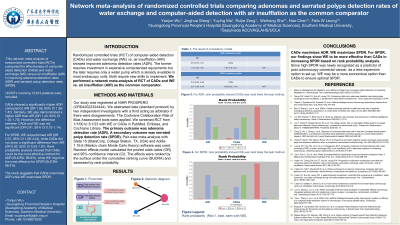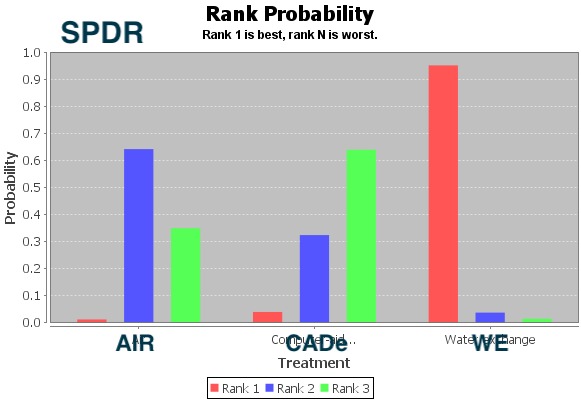Monday Poster Session
Category: General Endoscopy
P1981 - Efficacy of Water Exchange vs Computer-Aided Detection: A Bayesian Network Meta-Analysis of Randomized Controlled Trials
Monday, October 23, 2023
10:30 AM - 4:15 PM PT
Location: Exhibit Hall

Has Audio
- YW
Yanjun Wu, MD
Guangdong Provincial People's Hospital (Guangdong Academy of Medical Sciences), Southern Medical University
广州, Guangdong, China (People's Republic)
Presenting Author(s)
Yanjun Wu, MD1, Jinghua Wang, PhD1, Yuying Ma, MD2, Ruijie Zeng, MD2, Weihong Sha, PhD2, Hao Chen, PhD2, Felix W. Leung, MD, FACG3
1Guangdong Provincial People's Hospital (Guangdong Academy of Medical Sciences), Southern Medical University, Guangzhou, Guangdong, China; 2Guangdong Provincial People's Hospital, Guangzhou, Guangdong, China; 3Sepulveda ACC/VAGLAHS/UCLA, North Hills, CA
Introduction: Randomized controlled trials (RCT) of computer-aided detection (CADe) and water exchange (WE) vs. air insufflation (AIR) showed improved adenoma detection rates (ADR). The former requires investment in expensive computerized equipments but the later requires only a water pump which is already available in most endoscopy units. Both require new skills to implement. We performed a network meta-analysis of RCT of CADe and WE vs. air insufflation (AIR) as the common comparator.
Methods: Our study was registered at NIHR PROSPERO (CRD42022324444). We abstracted data (standard protocol) by two independent investigators with a third acting as arbitrator if there were disagreements. The Cochrane Collaboration Risk of Bias Assessment tools were applied. We screened RCT from 1/1/00 to 3/1/23 with WE or CADe in PubMed, Embase, and Cochrane Library. The primary outcome was adenoma detection rate (ADR). A secondary outcome was serrated polyp detection rate (SPDR). Pair-wise meta-analysis with Stata 15 (StataCorp, College Station, TX, USA) and Addis-1.16.6 (Markov chain Monte Carlo (MCMC) theory) software was used. Random effects model calculated the pooled odds ratios (OR) and 95% confidence interval (CI). The effects were ranked by the surface under the cumulative ranking curve (SUCRA) and assessed by rank probability.
Results: Eighteen RCTs with 13,613 patients (3,512 in CADe, 3,291 in WE and 6,810 in AIR). Data are reported as OR (95% CI). ADR: WE vs. AIR 1.43 (1.20,1.70), p< 0.05; CADe vs. AIR 1.56 (1.36,1.81), p< 0.05. WE vs. CADe 0.91 (0.73,1.14), p >0.05. SPDR: WE vs. AIR 2.07 (1.06,4.24), p< 0.05; CADe vs. AIR 0.92 (0.53,1.91), p >0.05. WE vs. CADe 2.23 (0.83,5.42), p >0.05 (Table). CADe had the highest efficacy on ADR (SUCRA: 89.8%). WE had the highest efficacy on SPDR (SUCRA: 99.3%) but lower ADR (SUCRA: 60.2%). For SPDR, rank probability showed WE was the best method (Figure).
Discussion: CADe maximizes ADR. WE maximizes SPDR. For SPDR, our findings show WE to be more effective than CADe in increasing SPDR based on rank probability analysis. Since low SPDR was newly recognized as a predictor of post colonoscopy colorectal cancer, as a less expensive option to set up, WE may be a more economical option than CADe to ensure optimal SPDR.

Disclosures:
Yanjun Wu, MD1, Jinghua Wang, PhD1, Yuying Ma, MD2, Ruijie Zeng, MD2, Weihong Sha, PhD2, Hao Chen, PhD2, Felix W. Leung, MD, FACG3. P1981 - Efficacy of Water Exchange vs Computer-Aided Detection: A Bayesian Network Meta-Analysis of Randomized Controlled Trials, ACG 2023 Annual Scientific Meeting Abstracts. Vancouver, BC, Canada: American College of Gastroenterology.
1Guangdong Provincial People's Hospital (Guangdong Academy of Medical Sciences), Southern Medical University, Guangzhou, Guangdong, China; 2Guangdong Provincial People's Hospital, Guangzhou, Guangdong, China; 3Sepulveda ACC/VAGLAHS/UCLA, North Hills, CA
Introduction: Randomized controlled trials (RCT) of computer-aided detection (CADe) and water exchange (WE) vs. air insufflation (AIR) showed improved adenoma detection rates (ADR). The former requires investment in expensive computerized equipments but the later requires only a water pump which is already available in most endoscopy units. Both require new skills to implement. We performed a network meta-analysis of RCT of CADe and WE vs. air insufflation (AIR) as the common comparator.
Methods: Our study was registered at NIHR PROSPERO (CRD42022324444). We abstracted data (standard protocol) by two independent investigators with a third acting as arbitrator if there were disagreements. The Cochrane Collaboration Risk of Bias Assessment tools were applied. We screened RCT from 1/1/00 to 3/1/23 with WE or CADe in PubMed, Embase, and Cochrane Library. The primary outcome was adenoma detection rate (ADR). A secondary outcome was serrated polyp detection rate (SPDR). Pair-wise meta-analysis with Stata 15 (StataCorp, College Station, TX, USA) and Addis-1.16.6 (Markov chain Monte Carlo (MCMC) theory) software was used. Random effects model calculated the pooled odds ratios (OR) and 95% confidence interval (CI). The effects were ranked by the surface under the cumulative ranking curve (SUCRA) and assessed by rank probability.
Results: Eighteen RCTs with 13,613 patients (3,512 in CADe, 3,291 in WE and 6,810 in AIR). Data are reported as OR (95% CI). ADR: WE vs. AIR 1.43 (1.20,1.70), p< 0.05; CADe vs. AIR 1.56 (1.36,1.81), p< 0.05. WE vs. CADe 0.91 (0.73,1.14), p >0.05. SPDR: WE vs. AIR 2.07 (1.06,4.24), p< 0.05; CADe vs. AIR 0.92 (0.53,1.91), p >0.05. WE vs. CADe 2.23 (0.83,5.42), p >0.05 (Table). CADe had the highest efficacy on ADR (SUCRA: 89.8%). WE had the highest efficacy on SPDR (SUCRA: 99.3%) but lower ADR (SUCRA: 60.2%). For SPDR, rank probability showed WE was the best method (Figure).
Discussion: CADe maximizes ADR. WE maximizes SPDR. For SPDR, our findings show WE to be more effective than CADe in increasing SPDR based on rank probability analysis. Since low SPDR was newly recognized as a predictor of post colonoscopy colorectal cancer, as a less expensive option to set up, WE may be a more economical option than CADe to ensure optimal SPDR.

Figure: Figure: For SPDR, rank probability showed WE was most likely the best method.
AIR, air insufflation; CADe, computer-aided detection; WE: Water exchange. SPDR, serrated polyp detection rate; (a). Rank probability for SPDR (Red 1, best, seen with WE).
AIR, air insufflation; CADe, computer-aided detection; WE: Water exchange. SPDR, serrated polyp detection rate; (a). Rank probability for SPDR (Red 1, best, seen with WE).
Disclosures:
Yanjun Wu indicated no relevant financial relationships.
Jinghua Wang indicated no relevant financial relationships.
Yuying Ma indicated no relevant financial relationships.
Ruijie Zeng indicated no relevant financial relationships.
Weihong Sha indicated no relevant financial relationships.
Hao Chen indicated no relevant financial relationships.
Felix Leung indicated no relevant financial relationships.
Yanjun Wu, MD1, Jinghua Wang, PhD1, Yuying Ma, MD2, Ruijie Zeng, MD2, Weihong Sha, PhD2, Hao Chen, PhD2, Felix W. Leung, MD, FACG3. P1981 - Efficacy of Water Exchange vs Computer-Aided Detection: A Bayesian Network Meta-Analysis of Randomized Controlled Trials, ACG 2023 Annual Scientific Meeting Abstracts. Vancouver, BC, Canada: American College of Gastroenterology.
